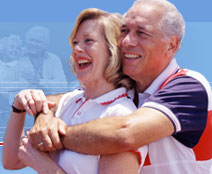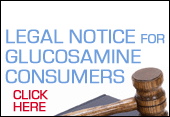|
We have talked a great deal about the use of glucosamine and other synergistic ingredients that are being used to ease the suffering of osteoarthritis. We have also talked a great deal about diet issues. Finally, we have talked about exercise.
You told us that it helps, but I don't get it!
I receive a lot of emails from individuals who are quick to point out that they tend to "slack off" on the exercise component. I cannot emphasize enough the importance of staying physically active and exercising when you suffer from OA. Most who contact me say that they have an "impression" that exercise is just too much (physical) effort and that they don't really see the need to do it.
If that is the case, I think that a more simplified approach to adding this important part of the healing process is in order. First, I would like to explain one more aspect that explains just how important this is.
Osteoarthritis and Muscle Toxicity
Arthritic muscles stay contracted for long periods of time. When they are in that condition, it causes lactic acid (waste products) to build up inside the muscle tissues and actually causes them to shorten or contract. When you suffer from spinal arthritis, this actually deprives or "starves" the discs, which in turn leads to rapid degeneration and consequently, (either) the onset of OA or a worsening of it.
Instead of trying to overcome this with a difficult regimen of exercise, let's talk about isometrics and the important (simple) role they can play.
Isometrics: Why They Help
When we are doing isometric exercises, it relaxes the muscles which allow them to stretch out to a normal position. This also eliminates the waste that builds up within those muscles when they are in a contracted state. As well, it allows for articular cartilage to nourish itself more efficiently and fully.
And what are isometric exercises?
Obviously, in answering some readers' questions, I am also leading up to an important point here. The beauty of isometric exercises is that anyone can do them, no matter what their age. They are simple (resistance or force) exercises that improve both mobility and flexibility. Let's take a simple example to illustrate the simplicity of isometric exercises that provide such great benefits.
The logic here is simple. A muscle is much easier to stretch after it has been contracted for say, ten to fifteen seconds. When using an isometric exercise for example, your muscle is up against or opposed by a wall or other immovable object. After you have finished holding the contraction, the muscle relaxes and stretches more easily. That's all there is to it.
This plays such an integral role for OA sufferers (1/3 of the healing process) that I would like to introduce you to a series of these exercises beginning with this one.
Exercise #1
The idea here is to get each of these exercises up to 10-15 repetitions daily. Each exercise should be done "holding" the given position for about 10-15 seconds. A simple way to remember this is to call it your 10-10 or 15-15 regimen. (Depending on how long you can hold them.) These exercises work best by the way when using a chair with no arms (ie. An office or kitchen chair).
- Sitting in chair, raise your arms straight over your head, keeping them level with your sides. Stretch in an upward motion and hold that position for 10-15 seconds.
Relax and then repeat this motion a number of times until you feel yourself
tiring.
- Now, while remaining seated place your hands behind your neck. Slowly
bring your elbows around until they are touching while still clasping the back
of your neck. Hold that position for the required time and then slowly move
your elbows back to the side of your head.
- Now, let's "stretch" things out a bit by moving your shoulders up, down, back
and forward in a circular motion.
- Next, move your head down to the left aiming your (left) ear toward your
shoulder. Do the same thing with the (right) ear.
- Finally, keeping your body in an upright position and keeping your feet flat on
the floor, take a good grip on the right side of the chair and both lean to the left
and pull with your hand. Repeat that same exercise from the other side.
Adding this first set of exercises is a start, is very simple, and takes little of your time. In the upcoming weeks, we will add a series of similar exercises to round out this light regimen that will truly accelerate your healing process.
J.R. Rogers is the founder and President of Activex America, Inc. makers of Liquid Glucosamine Formula Syn-flex®
|






